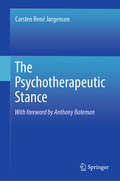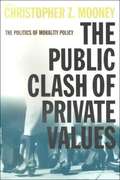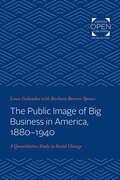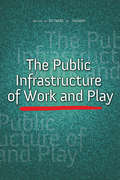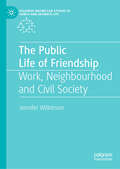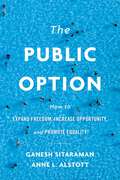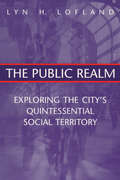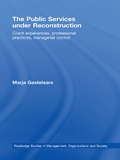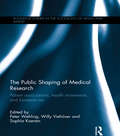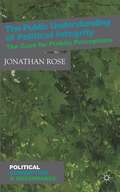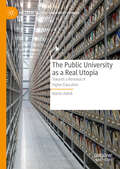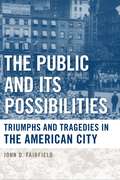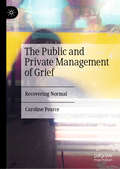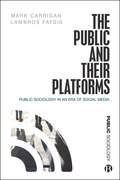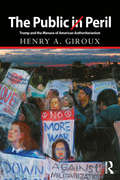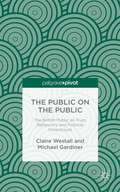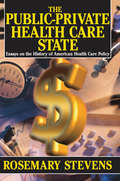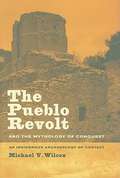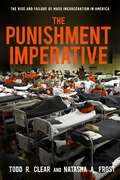- Table View
- List View
The Psychosocial And Organization Studies
by Kate Kenny Marianna FotakiLeading authors within organization studies and also from broader social science disciplines present the state of the art in the rapidly developing field of psychosocial approaches to organization studies and critical management studies.
The Psychosocial Imaginaries of Defence Nationalism: Far-Right Extremism in Australia and the UK (Studies in the Psychosocial)
by Liam GillespieThe Psychosocial Imaginaries of Defence Nationalism interrogates the emergence of far-right nationalist 'defence leagues' in Australia and the UK. Throughout the book, Liam Gillespie refers to these groups as defence nationalists: that is, as nationalists who imagine themselves as defenders of the nation and therefore national subjects par excellence. Drawing on original research, psychoanalytic and psychosocial theory—and particularly the work of Jacques Lacan—the author explores the narratives, imaginaries and subjectivities that sustain these groups, as well as the narratives, imaginaries and subjectivities these groups sustain. He argues that unlike other nationalist groups, defence nationalists are not primarily concerned with realising their avowed political projects. Instead, they are concerned with constructing and then enjoying themselves as the nation's self-ordained defenders. This means that which threatens the nation can paradoxically have a fortifying effect upon defence nationalists, legitimising and securing both the way they see themselves, and the position they see themselves occupying with/in the nation.The Psychosocial Imaginaries of Defence Nationalism will be of interest to anyone concerned with critical theorisations of contemporary nationalism, as well as with the application of psychoanalytic and psychosocial theory to social, cultural and political analysis.
The Psychosocial Interior of the Family (Social Problems And Social Issues Ser.)
by Gerald HandelDrawing upon findings from many disciplines including sociology, communication, family studies, human development, psychology and anthropology-this book provides the first composite study of the whole family and of the complex interplay between self and collectivity in family life. It departs sharply from the traditional two-person, cause-effect models used in conventional studies, and attempts to delineate a social psychology of the family.This book undertakes to define and understand the nature of families, to point out ways of discerning different family characters, and to comprehend the processes by which these characters are established and maintained; by so doing, it introduces a new dimension into the study of family behavior and provides a framework within which meaningful investigations and practical applications can be pursued.This long-awaited fourth edition continues the goal of preceding editions: to understand families in terms of the kinds of interaction through which family life is constructed. Contributors drawn from a wide variety of disciplines sociology; communication; family studies; human development; psychology; anthropology; and social work - provide a range of authoritative and up-to-date sources on the family and interpersonal relations, including newly emergent forms of family organization. In providing a new framework for fruitful investigation and practical application, this volume contains the best available interdisciplinary work on the social psychology of the family.
The Psychotherapeutic Stance
by Carsten René JørgensenThis book provides a thorough critique of the dominating medical understanding of psychotherapy and argues for a dynamic relational understanding of psychotherapy, deeply founded in the most important results from empirical psychotherapy research. In the first part, the book critically examines the traditional focus on technical factors in psychotherapy based on available empirical research on the subject. It asks questions about whether specific techniques cure specific diagnoses or therapists and therapeutic relationships that cure persons. Part II of the book argues that the currently dominating medical understanding of psychotherapy must be challenged by a better understanding of psychopathology and psychotherapy that contextualizes the relationship between therapist and the patient. Overall, this book provides a new approach to some of the most important questions in psychotherapy and discusses what it means to think and work psychotherapeutically. The book is highly relevant for professionals in clinical/psychotherapy training and for advanced courses in psychotherapy, including courses on mentalization-based therapy, psychoanalytic psychotherapy and eclectic psychotherapy.
The Public Clash of Private Values: The Politics of Morality Policy
by Christopher MooneyAbortion, capital punishment, gambling, homosexual rights, pornography, physician-assisted suicide, and sex education are among the most controversial issues facing public policymakers today. All involve controversial questions of basic principle/morality--When does life begin? Is gambling inherently evil? Should homosexuality be on a moral and legal par with heterosexuality? Mooney brings together top researchers in the field to explore the unique characteristics and politics of morality policy. The result is a definition of the current state of knowledge in the field and a guideline for future practice.
The Public Image of Big Business in America, 1880-1940: A Quantitative Study in Social Change
by Louis GalambosOtiginally published in 1975. At the time that Louis Galambos published The Public Image of Big Business in America in 1975, America had matured into a bureaucratic state. The expression of the military-industrial complex and big business grew so pervasive that the postwar United States was defined in large part by its citizens' participation in large-scale organizational structures. Noticing this development, Galambos maintains that the "single most significant phenomenon in modern American history is the emergence of giant, complex organizations." Today, bureaucratic organizations influence the day-to-day lives of most Americans—they gather taxes, regulate businesses, provide services, administer welfare, provide education, and on and on. These organizations are defined by their hierarchical structure in which the power of decision-making is allotted according to abstract rules that create impersonal scenarios. Bureaucracies have developed as a result of technological changes in the second half of the nineteenth century. Based on the premise that these structures had a stronger influence on modern America than any other single phenomenon, this book explores the public's response to the growth of the power and influence of bureaucracy from the years 1880 through 1930. What results is an examination of the social perception of bureaucracy and the development of bureaucratic culture.
The Public Infrastructure of Work and Play (The Urban Agenda)
by Michael A. PaganoA city's infrastructure influences the daily life of residents, neighborhoods, and businesses. But uniting the hard infrastructure of roads and bridges with the soft infrastructure of parks and public art creates significant political challenges. Planners at all stages must work at an intersection of public policy, markets, and aesthetics--while also accounting for how a project will work in both the present and the future. The latest volume in the Urban Agenda series looks at pressing infrastructure issues discussed at the 2017 UIC Urban Forum. Topics include: competing notions of the infrastructure ideal; what previous large infrastructure programs can teach the Trump Administration; how infrastructure influences city design; the architecture of the cities of tomorrow; who benefits from infrastructure improvements; and evaluations of projects like the Chicago Riverwalk and grassroots efforts to reclaim neighborhood parks from gangs. Contributors: Philip Ashton, Beverly S. Bunch, Bill Burton, Charles Hoch, Sean Lally, and Sanjeev Vidyarthi
The Public Life of Friendship: Work, Neighbourhood and Civil Society (Palgrave Macmillan Studies in Family and Intimate Life)
by Jennifer WilkinsonThis book is about friendships in public settings today. Wilkinson examines friendships in the public settings of neighbourhoods, civil society and at work. Identifying the unique relevance which public friendships have to contemporary social problems, the chapters cover a range of topics, including work-life balance, women’s ‘double burden’ and their leisure deficit, and contemporary neighbouring initiatives. Wilkinson shows how ‘friendship time’ at work provides solutions to new social problems including privacy: with the modern workplace being hyper-public and emphasizing visibility, monitoring and 24/7 availability, friendship’s combination of voluntarism and trust enable a private refuge even in an open-plan office. The book also explores the way in which friendships in public settings like work and neighbourhood provide community to those in society who are more likely to be excluded from private familial intimacy. The Public Life of Friendship will be of interest to students and scholars across a range of social science disciplines with an interest in friendship and the sociology of personal life.
The Public Option: How to Expand Freedom, Increase Opportunity, and Promote Equality
by Ganesh SitaramanA solution to inequalities—in health care, retirement, education, recreation, communication—is as close as the public library, post office, community pool, or elementary school. The Public Option shows that opportunities to develop reasonably priced government-provided services that coexist with private options are all around us.
The Public Realm: Exploring the City's Quintessential Social Territory
by Lyn H. LoflandThis book is about the "public realm," defined as a particular kind of social territory that is found almost exclusively in large settlements. This particular form of social-psychological space comes into being whenever a piece of actual physical space is dominated by relationships between and among persons who are strangers to one another, as often occurs in urban bars, buses, plazas, parks, coffee houses, streets, and so forth. More specifically, the book is about the social life that occurs in such social-psychological spaces (the normative patterns and principles that shape it, the relationships that characterize it, the aesthetic and interactional pleasures that enliven it) and the forces (anti-urbanism, privatism, post-war planning and architecture) that threaten it. The data upon which the book's analysis is based are diverse: direct observation; interviews; contemporary photographs, historic etchings, prints and photographs, and historical maps; histories of specific urban public spaces or spatial types; and the relevant scholarly literature from sociology, environmental psychology, geography, history, anthropology, and architecture and urban planning and design. Its central argument is that while the existing body of accomplished work in the social sciences can be reinterpreted to make it relevant to an understanding of the public realm, this quintessential feature of city life deserves much more u it deserves to be the object of direct scholarly interest in its own right. Choice noted that: "The author's writing style is unusually accessible, and the often fascinating narrative is generously supported by well-chosen photos."
The Public Services under Reconstruction: Client experiences, professional practices, managerial control (Routledge Studies in Management, Organizations and Society)
by Marja GastelaarsThis book examines the services in and around the public domain. The author analyses a number of socio-cultural changes that are generally considered relevant to these services, including the rationalising efforts of the New Public Management and the introduction of IT. The book particularly addresses the diversity of services. It focuses on the local complexities of their day to day processes of service delivery, and on the diversity of client experiences and professional roles associated with various client relationships. A practical objective of this book is to encourage its readers to ‘redefine’ the services they professionally deal with, and move beyond the standard requirements of the New Public Management that are so often taken for granted as a starting point. Professional managers are, for instance, invited to reconsider their currently quite dominant ‘technical’ managerial perspective. Service professionals are encouraged to make sense of the risks and responsibilities involved with their day to day negotiations, including the impact of the services on the lives of their clients. Gastelaars adopts and interpretive approach to her subject, combining discourse analysis and ethnographic research to concentrate on the actual practices associated with service delivery, rather than on theories and justifications.
The Public Shaping of Medical Research: Patient Associations, Health Movements and Biomedicine
by Peter Wehling Willy Viehöver Sophia KoenenPatient organizations and social health movements offer one of the most important and illuminating examples of civil society engagement and participation in scientific research and research politics. Influencing the research agenda, and initiating, funding and accelerating the development of diagnostic tools, effective therapies and appropriate health-care for their area of interest, they may champion alternative, sometimes controversial, programs or critique dominant medical paradigms. Some movements and organizations advocate for medical recognition of contested illnesses, as with fibromyalgia orADHD, while some attempt to "de-medicalize" others, such as obesity or autism.Bringing together an international selection of leading scholars and representatives from patients' organizations, this comprehensive collection explores the interaction between civil society groups and biomedical science, technology development, and research politics. It takes stock of the key findings of the research conducted in the field over the past two decades and addresses emerging problems and future challenges concerning the interrelations between health movements and patient organisations on the one hand, and biomedical research and research policies on the other hand. Combining empirical case studies with conceptual discussion, the book discusses how public participation can contribute to, as well as restrict, the democratization of scientific knowledge production.This volume is an important reference for academics and researchers with an interest in the sociology of health and illness, science and technology studies, the sociology of knowledge, medical ethics or healthcare management and research, as well as medical researchers and those involved with health-related civil society organizations.
The Public Understanding of Political Integrity
by Jonathan RoseThrough detailed analyses of major and newly available datasets, this study examines the utility of a public probity-focused approach to understanding citizen disaffection with politicians. It shows that perceptions of public probity are coherent, substantively meaningful, responsive, and, most importantly, that they do matter.
The Public University as a Real Utopia: Towards a Renewal of Higher Education (Palgrave Critical University Studies)
by Martin AidnikThis book theorises the public university as a real utopia, drawing upon the work of the American sociologist Erik Olin Wright. The book explores institutional democracy, academic freedom and the curriculum as the real utopian 'constituents' of the public university. In doing so, the author puts forward an argument for the redevelopment of public universities, seeking to do justice to both a radical vision and practical feasibility. This imaginative reconstruction of the university advances debate in the sociology and philosophy of higher education.
The Public and Its Possibilities: Triumphs and Tragedies in the American City
by John D. FairfieldIn his compelling reinterpretation of American history,The Public and Its Possibilities, John Fairfield argues that our unrealized civic aspirations provide the essential counterpoint to an excessive focus on private interests. Inspired by the revolutionary generation, nineteenth-century Americans struggled to build an economy and a culture to complement their republican institutions. But over the course of the twentieth century, a corporate economy and consumer culture undercut civic values, conflating consumer and citizen. Fairfield places the city at the center of American experience, describing how a resilient demand for an urban participatory democracy has bumped up against the fog of war, the allure of the marketplace, and persistent prejudices of race, class, and gender. In chronicling and synthesizing centuries of U. S. history--including the struggles of the antislavery, labor, women's rights movements--Fairfield explores the ebb and flow of civic participation, activism, and democracy. He revisits what the public has done for civic activism, and the possibility of taking a greater role. In this age where there has been a move towards greater participation in America's public life from its citizens, Fairfield's book--written in an accessible, jargon-free style and addressed to general readers--is especially topical.
The Public and Private Management of Grief: Recovering Normal
by Caroline PearceThrough a critical analysis of theory, policy and practice, The Public and Private Management of Grief looks at how 'recovery' is the prevailing discourse that measures and frames how people grieve, and considers what happens when people 'fail' to recover. Pearce draws on in-depth interviews with bereaved people and a range of bereavement professionals, to contemplate how ‘failures’ to recover are socially perceived and acted upon. Grounded in Foucauldian theory, this book problematises the notion of recovery, and instead argues for the acknowledgment of the experience of ‘non-recovery,’ highlighting how recovery is a socially and historically constructed notion linked to the individualised vision of health and happiness promoted by neo-liberal governmentality. This book will be of interest to students and scholars across sociology, anthropology, social work and psychology with a focus on death, dying and bereavement, grief studies, health and social care, as well as counsellors, clinical psychologists and social workers.
The Public and Their Platforms: Public Sociology in an Era of Social Media (Public Sociology)
by Mark Carrigan Lambros FatsisAs social media is increasingly becoming a standard feature of sociological practice, this timely book rethinks the role of these mediums in public sociology and what they can contribute to the discipline in the post-COVID world. It reconsiders the history and current conceptualizations of what sociology is, and analyzes what kinds of social life emerge in and through the interactions between ‘intellectuals’, ‘publics’ and ‘platforms’ of communication. Cutting across multiple disciplines, this pioneering work envisions a new kind of public sociology that brings together the digital and the physical to create public spaces where critical scholarship and active civic engagement can meet in a mutually reinforcing way.
The Public in Peril: Trump and the Menace of American Authoritarianism (Critical Interventions)
by Henry A. GirouxThis is one of the first books to thoroughly critique the rise of Trumpism and its potential impact, nationally and globally. One of the world’s leading social critics, Giroux offers new critiques of Trump and his early Cabinet choices in the context of longer term trends, including the rise of right-wing populism, the threat of planetary peril, anti-intellectual fervor, the war on youth, a narrowing political discourse, deepening inequality and disposability, authoritarianism, the crisis of civic culture, the rise of the mass incarceration state, and more. Giroux dissects the diverse forces that led to Trump’s rise and points to pathways for resisting his authoritarian instincts. Offering a new language of hope and possibility, Giroux’s optimism is rooted especially in the resurgence of progressive politics among youth. Giroux reclaims the centrality of education to politics and boldly articulates a vision in which the radical imagination merges with civic courage as part of a broad-based struggle for a radical democracy. Deep inquiries into fast-changing and pressing issues of our time makes this book 'the essential Giroux' that citizens and students must read, debate, and act upon.
The Public on the Public: The British Public as Trust, Reflexivity andPolitical Foreclosure
by Michael Gardiner Claire WestallIn Britain, the resistance to popular determination allowed by the financial construct of the public has been so successful that this term, public, must be re-read as politically paralyzing. The problem, our problem, is the public - which we are so often told will bring us together and provide for us - and it is this we must move beyond.
The Public-private Health Care State: Essays on the History of American Health Care Policy
by Rosemary A. StevensThe distinctive mixing and continuous remixing of public and private roles is a defining feature of health care in the United States. The Public-Private Health Care State explores the interweaving of public and private enterprise in health care in the United States as a basis for thinking about health care in terms of its history and its continuing evolution today. Historian and policy analyst Rosemary Stevens has selected and edited seventeen essays from both her published and unpublished work to illustrate continuing themes, such as: the flexible meanings of the terms public and private, and how useful their ambiguity has been and is; the role of ideology as ratifying rather than preordaining change; and the common behavior of public leaders and corporate entities in the face of fiscal opportunity. The topics--covering the period of 1870 through the twenty-first century--represent Stevens' research interests in hospital history and policy, the medical profession, government policy, and paying for health care. The volume also considers her involvement with policy questions, which include health services research, health maintenance organizations, and physician workforce policy. Section I demonstrates the long history of state government involvement with private not-for-profit hospitals from the 1870s through the 1930s. Section II examines the federal role in health care from the 1920s through the 1970s, including the establishment of veterans' hospitals and the implementation of Medicaid. Section III shows how shifting governmental roles require constantly changing organizing rhetoric, whether for inventing a federal role for health services research and HMOs, regionalization in the 1970s, or defining civil rights and equity as mobilizing vehicles in the 1980s. Section IV examines growing concerns from the 1970s through the present about the traditional public role of the largely private medical profession. Section V returns to the ambiguous public-priv
The Publishing Industry in China
by AntonioThe Publishing Industry in China is a timely volume that covers all aspects of China's book, magazine, and online publishing industry. Various chapters discuss the different market segments of trade, scientific, technical, professional, education, and children's books.
The Pueblo Revolt and the Mythology of Conquest: An Indigenous Archaeology of Contact
by Michael V. WilcoxMichael V. Wilcox upends many deeply held assumptions about native peoples in North America. His provocative book poses the question, What if we attempted to explain their presence in contemporary society five hundred years after Columbus instead of their disappearance or marginalization?
The Punic Mediterranean
by Josephine Crawley Quinn Nicholas C. VellaThe role of the Phoenicians in the economy, culture and politics of the ancient Mediterranean was as large as that of the Greeks and Romans, and deeply interconnected with that 'classical' world, but their lack of literature and their oriental associations mean that they are much less well-known. This book brings state-of-the-art international scholarship on Phoenician and Punic studies to an English-speaking audience, collecting new papers from fifteen leading voices in the field from Europe and North Africa, with a bias towards the younger generation. Focusing on a series of case-studies from the colonial world of the western Mediterranean, it asks what 'Phoenician' and 'Punic' actually mean, how Punic or western Phoenician identity has been constructed by ancients and moderns, and whether there was in fact a 'Punic world'.
The Punisher's Brain
by Morris B. HoffmanWhy do we punish, and why do we forgive? Are these learned behaviors, or is there something deeper going on? This book argues that there is indeed something deeper going on, and that our essential response to the killers, rapists, and other wrongdoers among us has been programmed into our brains by evolution. Using evidence and arguments from neuroscience and evolutionary psychology, Morris B. Hoffman traces the development of our innate drives to punish - and to forgive - throughout human history. He describes how, over time, these innate drives became codified into our present legal systems and how the responsibility and authority to punish and forgive was delegated to one person - the judge - or a subset of the group - the jury. Hoffman shows how these urges inform our most deeply held legal principles and how they might animate some legal reforms.
The Punishment Imperative: The Rise and Failure of Mass Incarceration in America
by Todd R. Clear Natasha A. FrostClear and Frost chart the rise of penal severity in the U.S. and the forces necessary to end itOver the last 40 years, the US penal system has grown at an unprecedented rate—five times larger than in the past and grossly out of scale with the rest of the world. In The Punishment Imperative, eminent criminologists Todd R. Clear and Natasha A. Frost argue that America’s move to mass incarceration from the 1960s to the early 2000s was more than just a response to crime or a collection of policies adopted in isolation; it was a grand social experiment. Tracing a wide array of trends related to the criminal justice system, this book charts the rise of penal severity in America and speculates that a variety of forces—fiscal, political, and evidentiary—have finally come together to bring this great social experiment to an end. The authors stress that while the doubling of the crime rate in the late 1960s represented one of the most pressing social problems at the time, it was instead the way crime posed a political problem—and thereby offered a political opportunity—that became the basis for the great rise in punishment. Clear and Frost contend that the public’s growing realization that the severe policies themselves, not growing crime rates, were the main cause of increased incarceration eventually led to a surge of interest in taking a more rehabilitative, pragmatic, and cooperative approach to dealing with criminal offenders that still continues to this day. Part historical study, part forward-looking policy analysis, The Punishment Imperative is a compelling study of a generation of crime and punishment in America.



